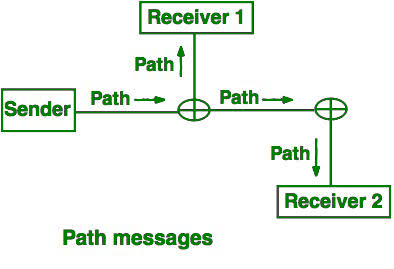Resource Reservation Protocol in Real-time Systems
Last Updated :
10 May, 2023
Resource Reservation Protocol (RSVP) is used in real-time systems for an efficient quality band transmission to a particular receiver. It is generally used by the receiver side for the fast delivery of the transmission packets from the sender to the receiver. Features of Resource Reservation Protocol:
- RSVP is receiver initiated. Receiver node in the real time system initiates the protocol.
- RSVP is simplex(unidirectional). The receiver node just receives the packets and does not want to send any data.
- Quality of Service is provided by RSVP protocol.
- Admission Control is used in RSVP at each hop in the network topology.
- Classification, buffer management, and scheduling is managed efficiently by RSVP
- It dynamically adapts to the change in route for the efficient message transfer.
- It is actually not a routing protocol. It depends upon other routing protocols.
- RSVP operates at the Transport layer of the OSI model and is used to reserve resources for a specific flow of data between a sender and receiver.
- It can be used for both unicast and multicast communication.
- RSVP uses soft state mechanism, which means that it periodically refreshes the state information for a particular flow of data.
- It supports different types of traffic, including constant bit rate, variable bit rate, and on-demand traffic.
- RSVP can be used in conjunction with Differentiated Services (DiffServ) to provide Quality of Service (QoS) in a network.
- It uses a signaling message called RSVP PATH message to request for resources and RSVP RESV message to reserve resources for a particular flow.
- RSVP can support multiple QoS levels for a particular flow of data.
- It is widely used in multimedia applications such as video conferencing, streaming, and online gaming.
Flowspec is used in RSVP to determines the different parameters like bandwidth, link strength, congestion, etc for smooth and collisionless communication and data transfer. Filterspec is used in RSVP for filtering of the packets. It is used to route the packets according to its destination type as a fixed or shared receiver.
Types of messages used in RSVP connection establishment:
- Reservation Message (resv): The receiver sends the Reservation Message (resv) to the sender, which specifies all the required resources and parameters for the reservation to establish.
- Path Message (path): Upon receiving the reservation message from the receiver, the sender records all the necessary resources to be reserved and records the path. The sender multicasts a Path Message (path) to all the receivers, which specifies the routing details of the packet. It also contains all the necessary specifications about the reservation to be made for the receiver.
Reservation Messages Transfer:

Path Messages Transfer:

The data sent by the sender in Resource Reservation Protocol is encrypted to prevent the data sent to the receiver from breach. Error reporting is done at the sender side in Resource Reservation Protocol for making the necessary changes in the communication strategy. In case of failure in RSVP, the admission state of the hop is sent to the requester for handling the necessary packets. In RARP the routers record the necessary forward and reverse routing state. The router may also make the necessary changes in the path message sent by the sender to the receiver to indicate the actual resource availability.
Advantages of Resource Reservation Protocol (RRP) in Real-Time Systems:
- Predictable Resource Allocation: RRP allows for the reservation of system resources in advance, ensuring predictable and guaranteed resource availability for real-time tasks. This enables the system to meet timing constraints and ensure timely execution of critical tasks.
- Deterministic Behavior: RRP provides deterministic behavior in real-time systems by allocating fixed resources to specific tasks. This determinism allows for precise timing analysis and ensures that tasks can meet their deadlines with high accuracy.
- Quality of Service Guarantees: RRP enables the system to provide quality of service guarantees by reserving resources based on the requirements of real-time tasks. It ensures that tasks receive the necessary resources and can operate within specified timing constraints, leading to reliable system behavior.
- Resource Optimization: RRP allows for efficient resource utilization by reserving resources only when they are needed. This prevents resource wastage and maximizes resource availability for other tasks, leading to overall improved system performance.
Disadvantages of Resource Reservation Protocol (RRP) in Real-Time Systems:
- Increased Resource Overhead: Implementing RRP requires additional resources for reservation and management, including memory for storing reservation information, computational power for scheduling and resource allocation decisions, and communication overhead for maintaining the reservation protocol. This can increase the overall resource overhead of the system.
- Limited Flexibility: RRP relies on static resource reservations, which may limit the flexibility and adaptability of the system. Changes in task requirements or dynamic workload variations may require manual reconfiguration of reservations, leading to inflexibility in resource allocation.
- Scalability Challenges: RRP may face scalability challenges in large-scale real-time systems with a high number of tasks and complex resource dependencies. As the number of tasks and resource requirements increase, managing and coordinating the reservations can become more challenging and may impact system performance.
- Reservation Conflicts and Deadlock Risks: In systems where multiple tasks contend for the same resources, conflicts, and deadlocks may arise if the reservation protocol is not carefully designed and managed. Resolving conflicts and avoiding deadlocks requires careful coordination and scheduling decisions, which can add complexity to the system design.
Like Article
Suggest improvement
Share your thoughts in the comments
Please Login to comment...